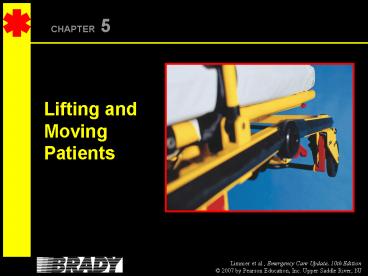Lifting and Moving Patients - PowerPoint PPT Presentation
1 / 51
Title: Lifting and Moving Patients
1
CHAPTER 5
Lifting and Moving Patients
2
Lifting Techniques
- Back injuries are a leading cause of long-term
disability for EMTs. - Lift safely.
3
Lifting Considerations
- Consider the weight of object/ patient.
- Communicate with partner.
- Identify the need for help before lifting.
- Have a plan.
4
Guidelines for Lifting
- Use your legs to lift.
- Have feet positioned properly.
- Keep weight close to body.
- Lift without twisting.
5
Use legs, not back, to lift.
6
Keep weight close to your body.
7
Power-LiftPosition
8
Power-Grip
9
Safe Reaching Techniques
- Keep your back locked in.
- Avoid twisting while reaching.
- Avoid reaching more than 15-20 inches in front of
your body.
10
Safe Pushing and Pulling
- Push, rather than pull.
- Keep your back locked in (whenever possible).
- Keep weight close to your body.
11
Safe Pushing and Pulling
- Keep your knees bent.
- Avoid pushing or pulling overhead.
- Keep elbows bent and arms close to sides.
- If weight is below waist level, push or pull from
a kneeling position.
12
Types ofMoves
13
Emergency Moves
- Scene is hazardous.
- Life-threatening condition requires move.
- Patient must be moved to reach a critical patient.
14
Emergency Move Clothes Drag
15
Emergency Move Incline Drag (Head-First)
16
Emergency Move FirefightersDrag
17
Emergency Move Firefighters Carry
18
Emergency Move One-Rescuer Assist
19
Emergency MoveTwo-Rescuer Assist
20
Urgent Moves
- Scene factors cause a decline in patient
condition. - Treatment of patients condition requires a move.
21
Urgent Move with Spinal Precautions
22
Non-Urgent Moves
- Use when there is no threat to life.
- Use when patients condition allows for
assessment and care. - Typically utilize a carrying device.
23
Non-Urgent MoveExtremity Carry
24
Patient-Carrying Devices
25
Wheeled Ambulance Stretcher
26
Portable Stretcher
27
Stair Chair
28
Long Spine Board
29
Patient Immobilized on Long Spine Board
30
Short Spine Board
31
Vest-Type Extrication Device
32
Patient Immobilized in Vest-TypeExtrication
Device
33
Scoop (Orthopedic) Stretcher
34
Basket (Stokes) Stretcher
35
Flexible (Reeves) Stretcher
36
Moving Patients toCarrying Devices
37
Carrying Device Choice
- What is the patients position?
- Is there a suspected spinal cord injury?
38
Patient Positioning
- Part of patient care plan
- Must not cause harm to patient
- Must be safe
39
Recovery Position Unconscious Patient without
Spinal Injury
40
Position of Comfort
41
Shock Position Patient without Spinal Injury
42
Transferring the Patient to a Hospital Stretcher
43
Position stretcher.
44
Pull sheet under patient taut.
45
Slide patient to hospital stretcher.
46
Be sure patient is centered. Raise side rail.
47
Review Questions
1. Describe the principles of safe lifting. 2.
Differentiate between emergency, urgent, and
non-urgent moves. Give example of each.
48
Review Questions
3. List several patient-carrying devices.
Describe a use for each. 4. Describe several
patient positions.
49
STREET SCENES
- What device should be used to remove the patient
from the vehicle? - What patient-care issues are important when using
an extrication device?
50
STREET SCENES
- What is the next thing to consider when actually
moving the patient from the vehicle? - What emergency-care equipment was used for this
patient? Why?
51
STREET SCENES
- What is the next step before moving this patient
again? - What other safety considerations should be
considered when moving the long board to the
wheeled stretcher?

